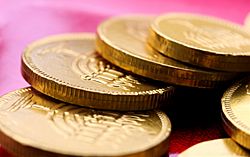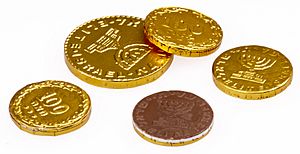Hanukkah gelt facts for kids

Chocolate gelt
|
|
| Alternative names | Gelt, Dmei chanukah |
|---|---|
| Type | Chocolate |
| Main ingredients | Chocolate |

Hanukkah gelt (Yiddish: חנוכה געלט ḥanukah gelt; Hebrew: דמי חנוכה dmei ḥanukah) means "Hanukkah money." It is a special gift, usually money or chocolate coins, given during the Jewish festival of Hanukkah. Children often receive gelt from their parents, grandparents, or other relatives. Sometimes, teachers also get gelt. It's a fun tradition that often goes along with playing the Dreidel game. In the 1900s, candy companies started making chocolate coins wrapped in shiny gold or silver foil. These chocolate coins became a popular way to give gelt.
Contents
History of Hanukkah Gelt
Real Money Gifts
Giving money as a gift during Hanukkah has been a tradition for a long time. It started in the 1600s with Jewish people in Poland. They would give money to their children. The children would then give some of this money to their teachers. Over time, children also started keeping some of the money for themselves.
Some people believe this tradition is connected to the amazing victory of the Maccabees. The Maccabees were Jewish warriors who fought against the ancient Greeks. When they won their freedom, they made their own national coins. Giving gelt might also have started in the 1700s in Eastern Europe. It was a way to thank religious teachers, much like giving a tip today. In 1958, the Bank of Israel even made special coins for Hanukkah gelt. These coins had a picture of the same menorah that was on Maccabean coins 2,000 years ago.
Chocolate Coin Gelt
In the 1900s, American chocolate makers got the idea to create chocolate gelt. They wanted to make a fun, edible version of the money gift. In the 1920s, a candy company called Loft's made the first chocolate gelt. These were chocolate coins wrapped in gold or silver foil. They often came in small mesh bags, just like real money bags. Another company called Bartons also started making them.
Today, many chocolate Hanukkah gelt coins sold in the United States are imported. Some come from Dutch companies like Steenland Chocolate. Others come from Israeli companies such as Elite and Carmit. You can even find fancy, gourmet versions of chocolate gelt made in the United States and Europe.
Hanukkah Gelt Customs
How Gelt is Used Today
Parents often give children chocolate gelt to play the dreidel game. Instead of using real money, kids can use the chocolate coins. This makes the game even more fun and delicious! Besides chocolate, parents, grandparents, or other relatives might give actual money as an official Hanukkah gift. A survey in 2006 showed that most parents in Israel give their children Chanukah gelt.
In some Hasidic Jewish communities, their spiritual leaders, called Rebbes, give out small coins to people who visit them during Hanukkah. Hasidic Jews believe that getting a coin from the Rebbe is a special blessing. They see it as a segulah, which means it brings good luck and success.
When Gelt is Given
Jewish law has rules about handling money on the Sabbath, which is a day of rest. Because of this, some people only give Chanukah Gelt on certain days of the week. They avoid giving it on the Sabbath.
See also
 In Spanish: Hanukkah gelt para niños
In Spanish: Hanukkah gelt para niños

